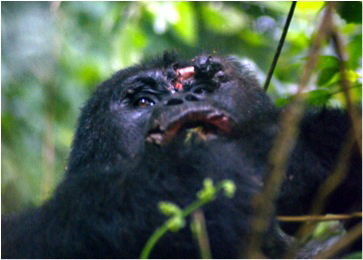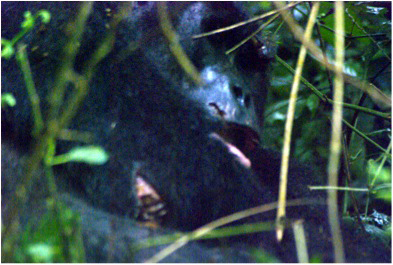Mishaya Group Clashes with Non-Habituated Gorilla Group in Bwindi
By Gorilla Doctors Staff on Tuesday, May 3rd, 2011 in Uncategorized.Mishaya is a silverback in Bwindi Impenetrable National Park, Uganda, who left Nshongi group in Bwindi last year with a few females to start his own group. He was able to gather a few other females from the other groups in the area, reaching a total of group size of 12 gorillas including three infants. Mishaya, the only adult male in the group, is reported to be a fighter who often starts interactions with other groups.
A few days ago a non-habituated group was seen in the area and on the morning of April 26, Mishaya group was discovered to have a few wounded members. The worst injuries were found in Mishaya himself and a 2-year-old infant. Both gorillas were reported by trackers as “severely injured.” MGVP veterinarians went to do a check on the following morning.
The group was quite far and it took us until 1:45 pm to locate them. It was heavily overcast and the rain started around 11:30 and carried on throughout observation time. Mishaya was found with the group, travelling and feeding, but clearly in pain. He was using all four limbs while walking slowly and when feeding, he clearly avoided moving his upper lip.
 Mishaya’s facial wounds.We were able to observe deep wounds on the upper lip and left eyebrow, swelling on the left upper eyelid, but no visible injury to the left eye was observed. Additional deep wounds were observed on the anterior surface of right elbow (the ulnar processus was fully exposed, but the full use of the limb defied joint penetration), both hands (5th finger on the right hand and the thumb of the left hand were very swollen and immobile), and below ankle of the right foot.
Mishaya’s facial wounds.We were able to observe deep wounds on the upper lip and left eyebrow, swelling on the left upper eyelid, but no visible injury to the left eye was observed. Additional deep wounds were observed on the anterior surface of right elbow (the ulnar processus was fully exposed, but the full use of the limb defied joint penetration), both hands (5th finger on the right hand and the thumb of the left hand were very swollen and immobile), and below ankle of the right foot.
 The wounded elbow.Despite his injuries he appeared alert and responsive, but moving slowly, presumably in pain. His stomach was quite full, and he was seen feeding yesterday and again today. His wounds seemed not life threatening.
The wounded elbow.Despite his injuries he appeared alert and responsive, but moving slowly, presumably in pain. His stomach was quite full, and he was seen feeding yesterday and again today. His wounds seemed not life threatening.
We found the injured infant with his father. His mother Bakunzi was feeding some 5 meters away. He had a deep wound on the face, which was difficult to assess due to the rain and darkness, but he was alert, travelling without difficulty and carrying some food in its hand. We did not have a chance to observe him feeding, as the infant was quite shy and kept hiding in the thicket, but his abdomen looked normally full. At this stage, his wound is not life threatening.
We carefully considered whether or not to intervene in the case of the more severely wounded Mishaya. Because of Mishaya is the only male in the group and the non-habituated group was possibly still in the area, our team came to conclusion that performing a full intervention would put the three infants at risk of infanticide from males outside the group. Also the late hour made it possible that females, disturbed during an intervention, would be forced to spend the night alone, and again increase the risk for their infants.
Delivery of antibiotics and possibly NSAIDs in a dart was also considered, but again abandoned, due to the two main reasons. First, to deliver the full dose would require four darts, and the chance that fully alert male would allow him to be darted so many times was very slim. Delivering just a part of dose would do no help, but would make the male nervous and avoid people on the following days. This, in a situation when daily close observation is essential for the vets to properly assess Mishaya’s progress, should be avoided at any cost.
We gave the trackers a detailed list of the factors to observe (time spent feeding, general activity, distance travelled every day, interactions with the females, feces, lameness) and instructions to report daily. If any worrying symptoms appeared, MGVP vets will go immediately to assess and treat if needed. Even if the reports are good, Dr. Fred will go to assess Mishaya on Saturday.
Please consider supporting the Gorilla Doctors by making a secure online donation. Every dollar you give goes to directly supporting our gorilla health programs and One Health initiative. Thank you for your generosity.
For the most up-to-date information about the Gorilla Doctors, “like” our Facebook page. You’ll find gorilla health reports, news items, photos, videos, and links to related content.


 Donate
Donate